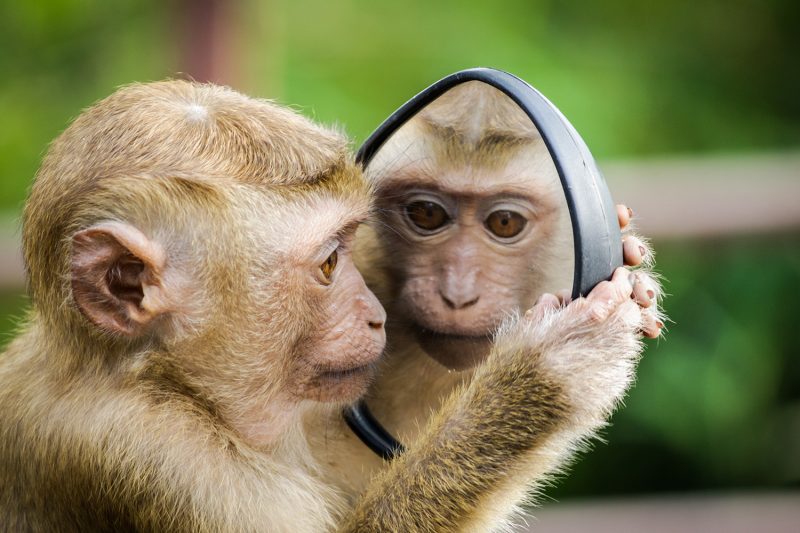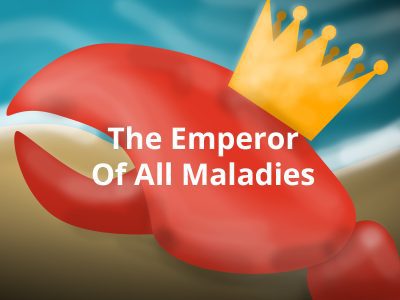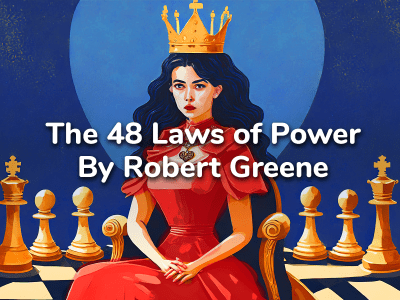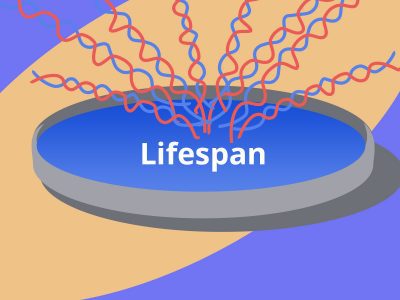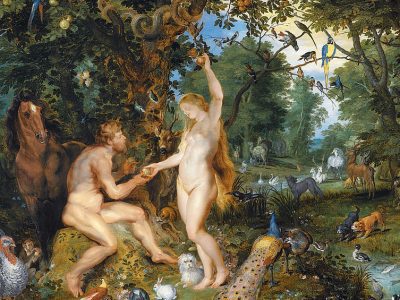Who was Terence McKenna?

(via WikiCommons)
Terence McKenna captivated the attention of the post 1960s counterculture. He was a lecturer, author and ethnobotanist, which means he studied how specific plants shaped human cultures.
In this book “Food of the Gods” which is also his most popular, he reveals a theory that psychoactive plants may have catalyzed the expansion of the human brain over 3 million years. This happened at a speed scientists are still astounded by. It was this growth in intelligence that allowed us to successfully spread across the planet and now sit at the top of the food chain.
However, this success came at a cost. With modern cities and technology, people feel more alienated than ever. This is exemplified by the ever-rising rates of mental illness and use of pharmaceutical drugs. There is also a tremendous destruction happening to the oceans, rainforests and planet. McKenna says that reawakening our relationship to certain psychoactive plants may help to pull us out of these negative trajectories, by allowing us to experience the interconnected relationship between us and nature.
“It is the mark of an educated mind to be able to entertain a thought without accepting it.” -Aristotle
Some parts of McKenna’s theory will probably turn out to be incorrect as future scientific and archaelogical evidence is uncovered. However, his ideas stimulate and provoke many to think in novel and unexpected ways, and they might do the same for you.
1. Human-plant relationships shape culture and have done so for millenia
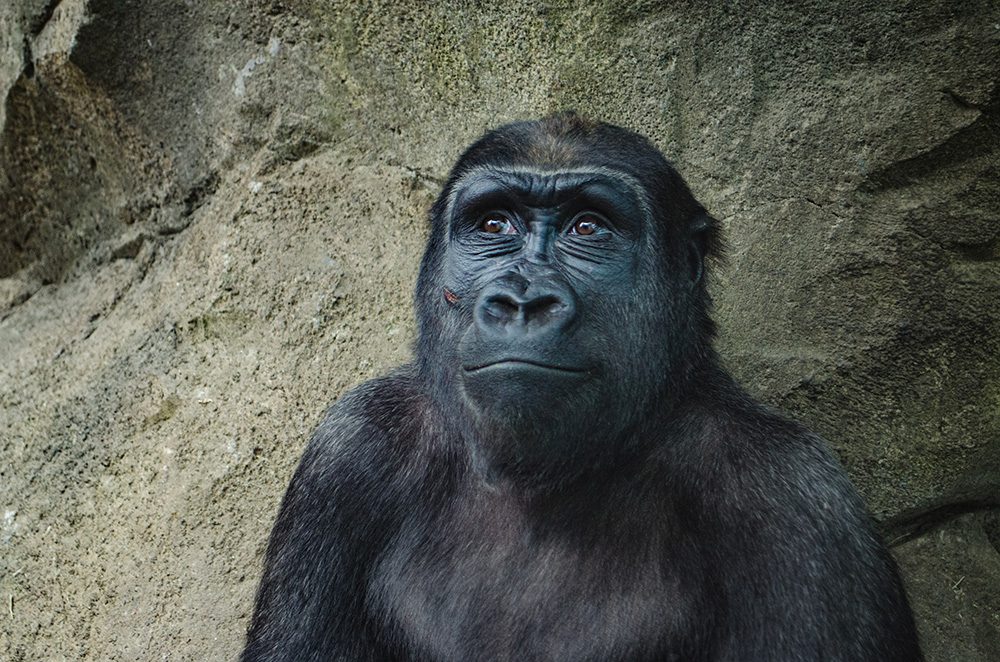
In Gombe Stream National Park (which is in Tanzania, East Africa) scientists noticed a chimpanzee tribe doing something very weird yet fascinating. (By the way, this is the same place Jane Goodall became famous for her long-term study of chimps.)
The scientists saw that one type of leaf kept showing up undigested in the chimp poo of the tribe. So they wondered, “Why would these chimps be eating leaves they couldn’t digest?” And the story gets stranger.
Every 10 days, the chimps would wake up and instead of going to their normal breakfast fruit eating spot, they walked more than 20 minutes away just to find these undigestible leaves, which the scientists noted were from the Aspilia plant. The chimps would pick off an Aspilia leaf, roll it around their mouth for a minute, and then swallow it whole. They repeated this with about 30 small leaves, and then left.
This behavior was a huge mystery to the researchers, until one day they heard about two new discoveries related to the Aspilia plant. First, a biochemist at UC Irvine called Eloy Rodriguez, had discovered a chemical in Aspilia leaves called thiarubrine-A. At the same time, Neil Towers at the University of British Columbia was studying the same oil but coming from a different plant. And he found thiarubrine-A acted as a strong antibiotic, killing bacteria and also helping get rid of parasitic worms in the intestinal tract!
Now the chimps strange behavior was starting to make sense. What if they were eating the leaves as a kind of herbal medicine? The scientists wondered if the native people living near the park also knew of the leaves. And it turns out they did. They used the leaves to treat wounds and stomach aches. What’s even more mind-blowing is that the native people only used leaves from 3 of the 4 local Aspilia species, and these were the same 3 species used by the chimps!
For many thousands of years, our relationships to plants have shaped human culture in deep ways. Just like some chimps will walk out of their way to get medicinal leaves, we humans have rearranged vast empires to access certain plant substances. But just like a goldfish can’t see the water it swims in, these plant relationships are so fundamental to who we are that we’re usually not aware of them. Let’s look at sugar as an example…
The European Sugar Fixation
Even to the 1600s, sugar was a rare and luxury commodity in Europe. Except for some kings and nobles, most people had never eaten sugar. Then in the 1700s, sugar became cheaper and it became available to the middle class for the first time ever. And as soon as people got a taste of it, demand surged. According to the BBC, average sugar consumption in Britain rose from 4lb per person in 1700, to 18lb in 1800, then to 36lb in 1850. A massive increase.
Around the same time, tea, coffee and cocoa also started being imported. They became popular because of the taste, because they’re all stimulants, and because they’re all boiled which helped stop the spread of waterborne diseases which were a big problem at the time. Another important fact is these substances are bitter, so people drank them with lots of sugar. The craze for coffee, tea and cocoa reinforced the craze for sugar. And in just a couple hundred years, these four plant substances went from being almost unknown to being consumed by everyone. Also important, they bacame the basis for entire trade empires and military fleets.

By 1750, sugar made up 1/5 of European imports, even more than grain. To satisfy the huge demand, dozens of plantations were established in the New World, especially the Caribbean. The first indentured labourers who worked there were white, but they kept getting sick from diseases like malaria and yellow fever.
So, needing more workers and ideally ones who wouldn’t drop dead of tropical diseases, they soon switched to slaves from Africa. It’s estimated at least 10 million people were brought across the Atlantic. On the ocean voyage alone, between 8-18% of them died. The rest were forced into a degrading life of hard labour. It was a dark chapter in human history.
Despite centuries of Christian moral conditioning, Europeans easily turned a blind eye to the wholesale kidnapping and transplantation of millions of people to satisfy their newfound taste for sweet cakes. The slave trade continued for over 200 years until slavery was finally abolished in 1807.
…Now a Worldwide Sugar Addiction
Yet today sugar has only become more popular. Average yearly sugar consumption has multiplied to over 160lb per year per person, according to the USDA. On average, we now eat over 10% of our calories from added sugar. And let’s be clear: sugar is totally unnecessary to the human diet. People survived for hundreds of millions of years without it. It is nothing more than a kick.

Lets also notice for a moment that sugar is not a harmless kick. It’s responsible for tooth decay and obesity, and studies show the countries with the highest sugar consumption also have the highest rates of type 2 diabetes.
Yet we still can’t resist picking up one more cookie if it’s sitting on the table. Why is that? Most of us would say it’s because sugar tastes great. A deeper explanation comes from scientists, who have found daily binging of sugar releases dopamine in our brains the same way addictions to hard drugs are formed. Yet in our culture, we put sugar in the “food” category and kids happily consume it daily, often showing emotional outbursts or distress if they can’t get their “fix.”
Coffee: A Behavior-Altering Drink
Now let’s switch gears and talk about coffee, another substance that feels essential to daily life. 64% of Americans drink coffee every day, often more than one cup. And on average we spend over $1,110 on coffee every year. Saying that you are addicted to coffee and need it to function has become a predictable joke, nonetheless coffee fits the definition of a drug because it is a stimulant and changes how one feels and behaves.
Caffeine supresses tiredness and makes one better able to focus on repetitive boring tasks. That’s probably why coffee is one of the few psychoactive substances not only tolerated, but encouraged by modern capitalist culture.
In 1952, a Pan-American Coffee Bureau ad campaign broadcast the message “Give yourself a Coffee-Break—and Get What Coffee Gives to You.” Overnight the term “coffee break” was born. Industrial unions were soon negotiating for coffee breaks to be written into every new union contract. And today it’s almost impossible to imagine what the modern office worker culture would look like without coffee.

Yet you may be surprised to learn the earliest evidence for coffee drinking only goes back about 500 years ago. In the middle east, coffee was first drank by Sufi mystics who used it as intoxication and to aid concentration while repeating the name of God. Soon, coffee houses were springing up everywhere, including in Mecca where people, energized by coffee, passionately discussed politics. Coffee was actually banned there in 1511 by the more conservative and orthodox imams who worried the drink stimulated radical thinking. (Although this order was soon overturned by a higher level of government.)
Banning coffee on fear of revolution sounds a bit crazy, yet their fears may not have been totally unfounded. Terence McKenna observed that coffee may have stimulated French people into a revolution only 100 years later:
Coffee was introduced in Paris in 1643, and within thirty years there were over 250 coffee houses in the city. In the years immediately preceding the French Revolution there were nearly 2,000 coffee establishments operating. If wild talk is the mother of revolution, then certainly coffee and coffee houses must be its midwife.
What’s the lesson here? Coffee, like sugar, looks innocent on the surface. Our double mocha soy macchiato from Starbucks helps us get through those dreary Monday morning a little more easily. Yet when most people collectively start drinking this stimulant, it’s no exaggeration to say coffee reshapes our culture in its own image, by enabling and reinforcing certain behaviors. Coffee helps us get focused on boring work a little faster and makes our speech a little more feverish.
What would the world look like without sugar or caffeine? There’d be no McDonald’s, no Starbucks or any other fast food restaurants or coffee shops. And we’ve only looked at two plant substances out of thousands that shape our society. Now here’s something else to think about: What if in the forgotten past we had relationships with other plants that shaped human culture in radically different directions?
In the same way chimps in Tanzania change their behavior to get medicinal leaves, humans also radically reshaped our behaviors and cultures to access certain plant substances. Sugar, caffeine, tea and cocoa went from totally unknown in the 1600s, to a European craze that caused the slave trade a couple hundred years later, and today we can’t imagine life without them.
2. Pre-humans may have consumed psilocybin mushrooms on the African Savannah, accelerating our evolution
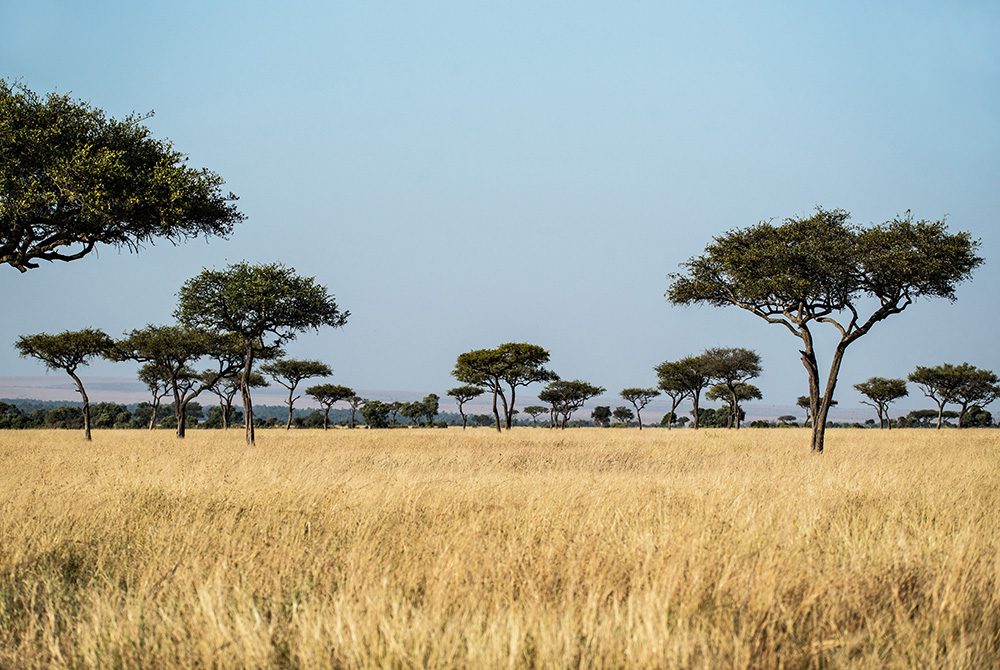
We humans have the largest brains in the animal kingdom, in proportion to our body size. Yet our brains actually used to be a lot smaller, then in the past 3 million years human brains tripled in size, with the fastest growth happening between 800,000 and 200,000 years ago. Scientists are still unsure of how our brains grew so big, so fast. This is a big deal because our large brains allow us to be, well… human. Everything that is uniquely human about us stems from our cognitive ability including: language, painting, poetry, sports, religion, politics and music.
To put it in perspective, the brains of our closest animal relatives the great apes (like chimps, gorillas and bonobos)… their brains barely changed in size in the past 10 million years.
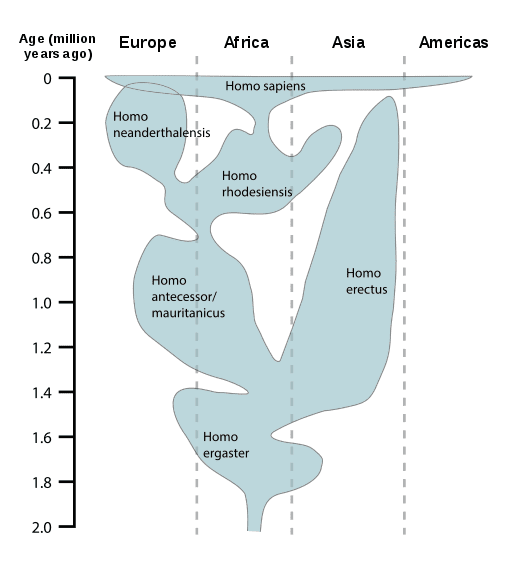
So why did our brains grow so much? Some scientists believe cooking is responsible. When humans began cooking, it allowed us to consume more calories with less energy needed for digestion. Our intestines became a lot shorter, and a lot of that new excess energy was diverted to our brains. However, other scientists say widespread use of fire for cooking only happened AFTER our brains had grown a lot. In other words, cooking was the effect of being smart, not the cause. But nobody is really sure yet.
There is a another theory that looks very promising. Some scientists noticed the fastest brain growth in humans happened at the same time the climate was changing most rapidly. So they speculate times of climate fluctuation put large pressure on humans to develop a bigger brain that helped them adapt to a rapidly changing environment. In plain English, if the forest you’re living in suddenly shrinks and you’re forced into grasslands, then you’d better be smart enough to find new ways of putting calories in your mouth, or you die. So the smartest, biggest brained and adaptable humans lived and passed on their genes.
Did psilocybin mushrooms grow on the ancient African savannah?
Now, here’s where Terence McKenna steps in with his own guess for what caused the brain growth. He says when climate change did force our ancestors from forests to grasslands, they were suddenly surrounded by hooved herbivores. Considering how many prehistoric paintings feature bison, they were likely an important food source.
And this also means coming into constant contact with the manure of these animals. (You may see where this is going.) Some hallucinogenic mushrooms prefer to grow in cow manure, including Psilocybe Cubensis, a dung-loving species of what are colloquially called “magic mushrooms.”
If there were psilocybin mushrooms growing in ancient African cowpies, then would humans have tried them? It’s very likely. Unlike the panda that only eats bamboo, humans are an omnivorous animal and our dietary flexibility is a main reason we’re so successful in every environment: from jungles to deserts to arctics to tropics. Certainly mushrooms would have been noticeable to a hungry wandering ape, with their unique shape and inviting smell.
Psilocybin could have given pre-humans 3 specific advantages
Now, Terence McKenna also says psilocybin mushrooms would have given proto-humans 3 key evolutionary advantages:
- First, because small doses of psilocybin slightly enhance visual abilities. This was shown by a scientific study in the 1960s by Roland Fischer that found people who consumed a low dose of psilocybin could detect more quickly when previously parallel lines became skewed. To hunter-foragers enhanced vision would have been very useful, giving them an edge in spotting food and avoiding predators.
- Second, slightly larger doses of psilocybin stimulate restlessness and arousal. As McKenna says wryly, stimulated arousal in apes leads to what a scientist might describe as “more instances of successful copulation.” Another slight evolutionary advantage.
- Finally, at high doses psilocybin induces a transcendent state. A state where profound self reflection occurs. Many people report feeling a sense of unity and interconnectedness, psychological boundaries dissolving.
From the outside, these altered states of consciousness may be labeled as simply drug-induced hallucinations. Yet maybe the experience shouldn’t be brushed aside so quickly. Roland Griffiths of John Hopkins University began the first modern scientific studies on psilocybin in 1999. (Psilocybin is the active ingredient of the so-called “magic mushrooms.”) These studies began researching the effects of a psychedelic experience for people who are depressed, addicted to cigarettes or dying of cancer. And the lead researcher was shocked because in questionnaires collected a month after the studies, more than two-thirds of patients rate their psychedelic journey as one of the most important experiences of their life. In fact, about 50% say it’s the single most spiritually significant experience of their life, on par with the birth of a child or death of a parent.
What this means is, a single experience with psilocybin is very powerful and significant. The same researcher found that psilocybin creates long-term measurable personality change, something traditionally thought to be fixed after the mid-twenties. It consistently made people score higher in traits related to “openness” and creativity.
McKenna’s theory is not that archaic apes ate mushrooms and their brains grew bigger. Rather, he thinks hallucinogenic experiences opened their minds to novel ways of thinking, new patterns of behaving and more complex expressions of language and culture. This might include more effective and coordinated hunting strategies. It might include shared religious beliefs, leading to more cohesive communities. It especially would include new ways of using language.
Psilocybin specifically activates the areas of the brain concerned with processing signals. A common occurrence with psilocybin intoxication is spontaneous outbursts of poetry and other vocal activity such as speaking in tongues.
The increasingly complex nature of social life would then have created an evolutionary preference and selection pressure for humans with ever-larger brains and more mental power. In fact, in 1992 the British scientist Robin Dunbar became famous for showing a connection in primates between the size of their social groups and the relative size of their neo-cortex. (The neo-cortex being the newest part of the brain used for processing complex information.) So what Dunbar discovered is the neo-cortex is relatively small in primates that hang out in small tribes, like the Tamarkin monkey which lives in groups of about 5. But as you study primates living in larger and larger groups, you see their neo-cortexes also being larger and larger. This led Dunbar to create what’s known as “The Social Brain Hypothesis” which says humans evolved a complex brain to handle social relationships within the tribe, rather than to handle the outer environment as previously thought.
Human brains tripled in size in the past 3 million years. This fast growth happened during climate fluctuations, our ancestors being pushed from forests into grasslands where they may have found psilocybin mushrooms. These could offer some evolutionary advantages, like enhanced visual acuity at low doses and at high doses the introduction of more complex patterns of language and culture. Studies show a hallucinogenic experience makes people measure higher in personality traits related to “openness” and creativity.
3. Prehistoric artifacts hint at the ritual use of psychoactive plants

On a hard-to-reach plateau in Algeria, North Africa, there’s a place called Tassili n’Ajjer which is home to thousands upon thousands of ancient artworks. This place is now a desert, but 10,000 years ago when these cave paintings and engravings were created, the surroundings were a lush savannah. And many of the paintings portray large animals like antelopes and cattle herds. Other painting show abstract geometric patterns or humans engaged in hunting and dancing. This place is seen as one of the most important centers of prehistoric art in the world.
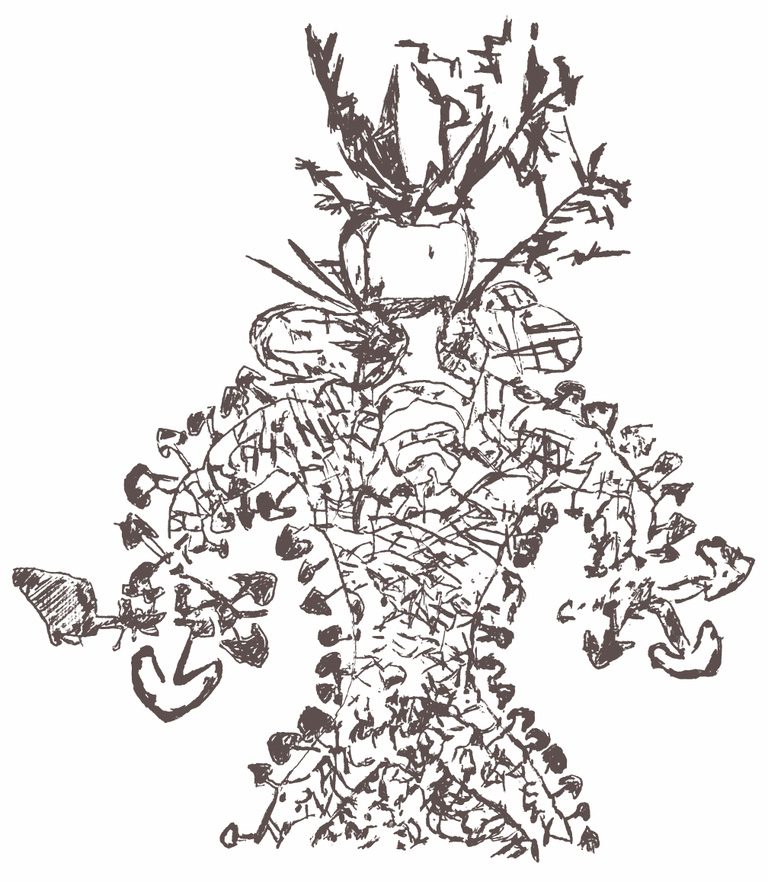
And one of the most striking paintings in Tassili n’Ajjer is of a figure believed to be a shaman, wearing a mask striped like a bee and it looks like he’s doing some kind of dance or ritual. But the most interesting part of this painting is that his hands appear to be full of mushrooms and his body seems to be covered from head to toe in small mushrooms.
That’s not all. There’s another painting in Tassili n’Ajjer of the so-called ‘mushroom runners’. (Here is the original rock art.) Here’s how Terence describes this second painting:
The shamans are dancing with fists full of mushrooms and also have mushrooms sprouting out of their bodies. In one instance they are shown running joyfully, surrounded by the geometric structures of their hallucinations’. The pictorial evidence seems incontrovertible.
Well, what could these paintings mean? What are they evidence of? Are they just regular mushrooms drawn for their interesting shape? Or could psychoactive mushrooms have been part of the rituals of these archaic people?
And these are not the only prehistoric artworks that raise questions. Take for example, the 6,000 year old Selva Pascuala mural near Cuenca, Spain. There is a clear shape of a horned bull and to the bottom right of it what appears to be a line of many small mushrooms. And in fact, a 2011 paper in the Journal of Economic Botany hypothesized these small mushroom shapes resemble a kind of psychoactive mushroom native to the area called psilocybe hispanica.
The Mystery of Soma
Now, let’s fast forward several thousand years to talk about the ancient and mysterious drink called Soma. First we need to mention the Rig Veda, which is one of the oldest religious texts in existence, written down around 4,000 years ago. The Rig Veda is still a foundation of Hinduism today.
Now, the Rig Veda is split into 10 different books which are called Mandalas. And here’s something very fascinating. The 9th Mandala, which makes up 10% of this entire ancient text, is entirely dedicated to a mysterious drink called Soma and the religious rituals surrounding Soma. There are over 114 hymns praising the magical and healing properties of this drink. Here’s an example of how they sound:
It is drunk by the sick man as medicine at sunrise; partaking of it strengthens the limbs, preserves the legs from breaking, wards off all disease and lengthens life. Then need and trouble vanish away, pinching want is driven off and flees when the inspiring one lays hold of the mortal; the poor man, in the intoxication of the Soma, feels himself rich; the draught impels the singer to lift his voice and inspires him for song; it gives the poet supernatural power, so that he feels himself immortal.
Rig Veda, translation is from Food of the Gods book
In short, Soma sounds like powerful, almost-miraculous stuff. So what was it? That’s the mystery. Nobody really knows. The true identity of Soma was slowly forgotten over thousands of years of cultural and environmental changes. But recently, several scholars have tried to guess what the ancient drink was.
The Rig Veda contains some hints. It says Soma was made from a mountain plant. Soma was also drunk before battle by warriors. So some scholars have speculated the drink was based on the plant Ephedra which contains the powerful stimulant Ephedrine. Others argue cannabis must have been the main ingredient of Soma. Or perhaps it was a plant called Peganum Harmala which has psychoactive properties.
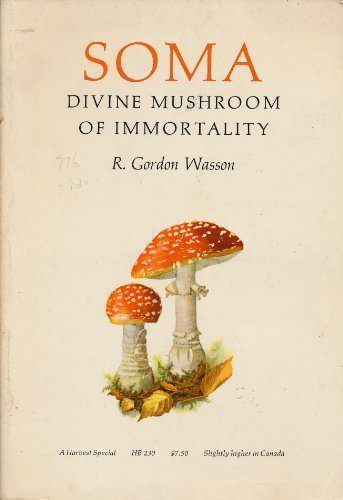
In 1971, an author McKenna highly respects called Gordon Wasson published the book “Soma: Divine Mushroom of Immortality” where he argued that a non-psilocybin mushroom called Amanita Muscaria was the main ingredient in Soma. This mushroom, which is bright red with white spots, is an image most of us are very familiar with. It became the archtypal mushroom depicted in fairy tales and later even in Super Mario Bros and emojis. This mushroom contains two mind-altering neurotoxins called ibotenic acid and muscimol. Some people leave bits of this mushroom in milk to kill flies, earning it the name fly agaric.
However, those who have tested consuming this mushroom including Terence McKenna himself found it not to give a positive experience. McKenna says the only effect he and his companions felt after eating it was nausea and sleepiness. Certainly nothing like what is described in the Rig Veda.
But this book did open his mind to the possibility that Soma is based on a mushroom. The Rig Veda does say the cow is the embodiment of soma, which implies a strong connection between the two. Cows themselves attained a sacred status in Hinduism, with their dung and urine used in rituals. Of course, psilocybin mushrooms grow in cow dung. Certainly psilocybin which gives otherworldy hallucinogenic experiences, is one of the few substances which might live up to the ecstatic verses in the Rig Veda.
Some prehistoric art depicts mushrooms, including in Algeria painting of a figure believed to be a shaman wearing a bee mask, his fists full of mushrooms and he is covered in small mushrooms from head to toe. Another 6,000 year old mural in Spain depicts a bull standing near a line of small mushrooms some scientists say resemble a local species of psilocybin mushroom. And one of the oldest religious texts the Rig Veda heavily praises a drink called Soma. Nobody today knows what Soma was made of, but many speculate it must have contained psychoactive and/or hallucinogenic plants.
4. Several thousand years ago, humans shifted from ‘partnership’ to ‘dominator’ societies that emphasize hierarchy, conformity and order
We all have a dim and distant, almost unconscious memory of a long lost paradise. Proof of this is the story of Adam and Eve, living in the lush, abundant Garden of Eden. The importace of this story can’t be overstated. It’s the foundational myth, the source code of western culture. It’s at the very beginning of the most widely-read book of the past 2000 years. And while some people, especially those steeped in scientific materialism, would say the story is just a stale superstition designed to frighten people into obedience… Well, maybe there’s more to it than that.
Carl Jung would say the Adam and Eve myth arose out of humanity’s collective unconscious. That’s why the story speaks to something deep inside each of us, it seems to communicate something about the nature of reality we all feel to be intuitively true. (Even if some of our rational minds do not accept it as scientifically true.)
And what does it mean that the foundational book of Western civilization, right at the beginning tells a story of humans finding and consuming a psychoactive plant? What does it mean that their eyes were then opened and they became self conscious? As Terence McKenna jokes, this sounds like the story of history’s first drug bust.
Were some prehistoric cultures based on partnership?
What if the Garden of Eden was not just a myth, what if it represents a memory of a time that actually existed? When we look at some prehistoric cultures, we see an emphasis on respect for nature and all that is life-giving and nurturing. For example, ancient cities like Catal Huyuk or the island of Minoa contained many female figurines (likely tributes to female fertility or goddesses) that far outnumbered male ones. This is a stark contrast to the Abrahamic religions today that have always represented god as an old white bearded man.
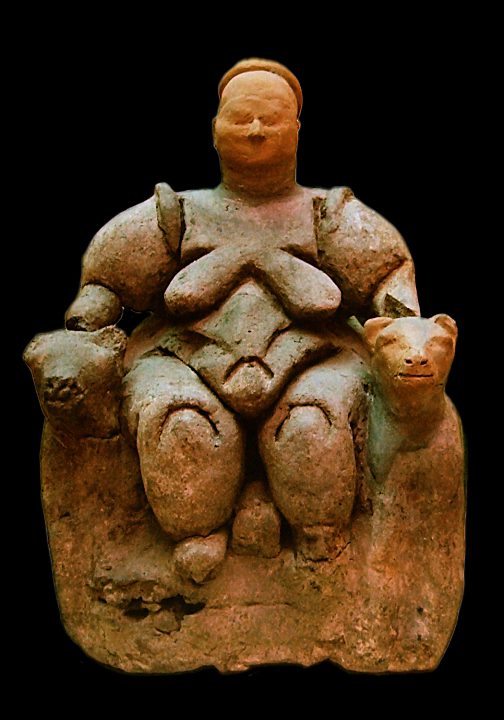
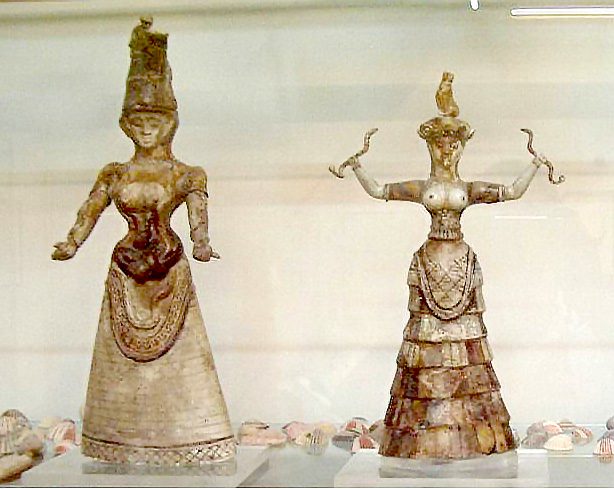
Terence McKenna says 7-10 thousand years ago, our archaic ancestors lived in a very different society than most of us do today. Because of rituals involving psychoactive plants, they regularly experienced oneness with nature and the dissolution of their personal ego. These experiences created a shift in values towards worship of the Mother Goddess and a more egalitarian, harmonious social structure. These are values typically connected to the feminine.
But 5-7 thousand years ago, invasions of warlike, nomadic tribes brought an end to that era and shifted us to what could be described as “dominator” societies. These societies were now based on rigid hierarchy, authority, conformity, control and they rely on violence to survive. Riane Eisler first coined these terms ‘partnership’ and ‘dominator’ societies in her bestselling book The Chalice and the Blade.
The rise of ‘dominator’ societies
The plant-based and open-ended shamanistic spirituality of partnership societies was quickly suppressed and it was replaced with traditions of dogma and priestly hierarchies. The dominator social structures know instinctively that altered states of consciousness are an existential threat to them. Why? Because certain plant rituals dissolve ego boundaries and help one see oneself as part of the interconnected web of life, a view tinted with the feminine. This religious shift led to new social and gender imbalances, wars and as we are now seeing, the destruction of nature itself.
Dominator societies also have a hostile attitude towards sexuality, another perfectly natural experience that is taboo because it dissolves ego boundaries. In all dominator societies the relationships between men and women are centered on men being sought for security and apparent status. In partnership societies, this was less likely to happen because kids were raised in a more group-minded way and resources were more equally distributed among all members rather than accumulating to a few older males.
What arose with dominator societies was monotheism. As McKenna describes it:
Monotheism exhibits what is essentially a pathological personality pattern projected onto the ideal of God: the pattern of the paranoid, possessive, power-obsessed male ego. This God is not someone you would care to invite to a garden party.
Related to this is how much of a threat the medieval church saw in witchcraft. Just 400 years ago, the medieval followers of Christ were so terrified of witches they murdered at least 30,000 through torture and burning. It’s probably not a coincidence most of those were female, as spiritual knowledge of the natural world is felt to be a feminine domain even today. As an aside, the plants usually associated with European witchcraft like thorn apple, mandrake and nightshade are not hallucinogenic, but they are psychoactive in a way, producing states of delirium and derangement. That may explain the image of the mad, cackling witch.
Perhaps prehistoric people, inspired by hallucinogenic ego-dissolving experiences, structured their societies around ‘partnership’ values like harmony, equality and worship of the Mother Goddess. (The abundance of female goddess figurines found in Catal Huyuk or Minoa hint at this.) Later these were replaced with so-called ‘dominator’ societies that practice religious dogmatism and emphasize hierarchy, order and strict boundaries.
5. Personal, social and ecological balance in the world may be restored by shamanic plant rituals
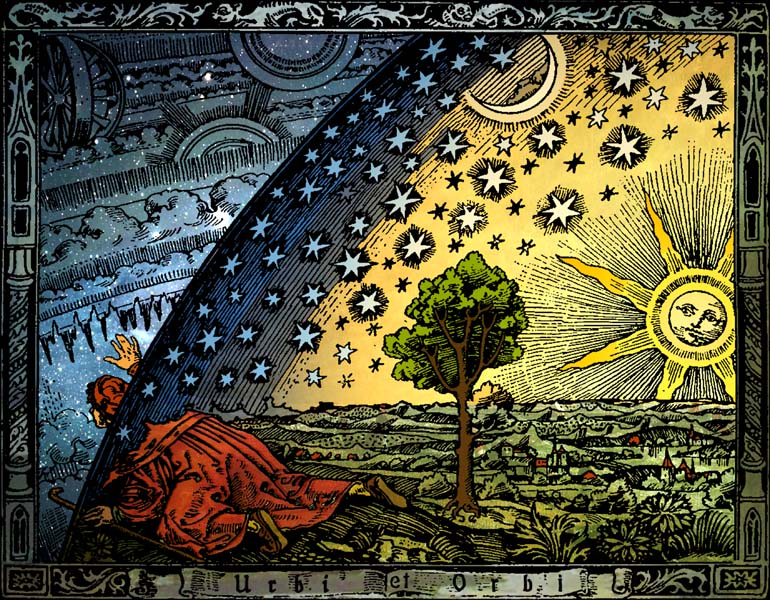
Albert Hoffman was a chemist working for a pharmaceutical company in Switzerland. In 1943 while researching different chemicals, he was the first person to synthesize lysergic acid dietylamide, also called LSD. He sythesized it and then forgot about it for years while World War 2 happened. After the war, he randomly returned to this chemical again and a small amount of LSD touched his skin. It triggered effects like a very active imagination and sensitivity to light. It was then Hoffman knew he’d found something very peculiar.
Three days later, on April 19th 1943, Hoffman intentionally ingested 250 micrograms of LSD. He thought this was a very small dose, but because LSD is so concentrated, it was actually a very high dose. LSD takes an hour or more to kick in, so Hoffman didn’t feel the effects right away. After a while he felt nothing, so he began riding his bike home from work, as is normal in Switzerland. Needless to say, in the middle of the bike ride the hallucinogenic effects of LSD came on so strongly he couldn’t make it all the way.
It gave me an inner joy, an open mindedness, a gratefulness, open eyes and an internal sensitivity for the miracles of creation…. I think that in human evolution it has never been as necessary to have this substance LSD. It is just a tool to turn us into what we are supposed to be.
Albert Hofmann, Speech on 100th birthday in 2006
The wild experimental 60’s
A couple decades later in the 1960s, LSD went mainstream. Probably due to the efforts of figures like Timothy Leary, a controversial professor at Harvard. And the 1960s were an extraordinary window where sudden widespread use of psychoactive substances brought tremendous social change. An amount of social turbulence not seen in America in at least 100 years.
Terence McKenna describes hallucinogens as “de-conditioning agents.” They allowed the younger generation to see the relativity of cultural values and therefore the freedom not to conform to those values. At the same time, there was an explosion of new colors, music and art. The vibrant and groundbreaking music of the Beatles being a good example.
Yet near the end of the 60s, the government panicked at what was happening and prohibited all psychedelics including those nobody had even heard of at the time, like ibogaine and bufotinin. This move was not based on any medical or scientific evidence. In fact, a lot of promising scientific research being done at the time was soon squeezed out of existence.
For example, several clinics were using LSD to treat alcoholism and a recent meta-analysis of those studies found 59% of patients improved with the help of LSD, compared to 38% in the control group. Further, researchers noted how patients commonly felt they had gained significant insights into their problems and been given a new lease on life. And they said this might be the result of LSD binding with certain serotonin receptors in the brain, stimulating new connections and opening the mind to new possibilities.
Nonetheless, psychedelics became taboo in the scientific world and research was not funded into them for decades. Until very recently.
In the past 10 years, there has been a kind of renaissance in psychedelics research, led by Roland Griffiths at John Hopkins University. His most well-known study up to now was giving psilocybin to terminally ill cancer patients. He found large and long-lasting decreases in depression and anxiety. 6 months later participants continued to report the same improvements in quality of life. And that’s from one dose of psilocybin, which is an unprecedented result.
Ayahuasca and the shamanic experience
Let’s look at Ayahuasca now. Ayahuasca is a particularly powerful psychoactive brew made by indigenous people living in the Amazon basin and it has a long shamanic tradition behind it.
To make Ayahuasca, you need two different plants. First you need leaves from the psychotria virdis plant, which contain dimethyltriptamine (or DMT for short). And you also need vines of another plant called banisteriopsis caapi which contain what’s called MAO inhibitors. Now here’s something crazy: either of these plants consumed alone does nothing. But consumed together, the MAO inhibitors allow the DMT to enter the brain’s serotonin receptors and create intense visionary experiences. How did the native people learn to boil these two specific plants together out of thousands in the Amazon? Nobody knows and it’s quite the mystery, especially considering the mechanism of MAO inhibition was not described by modern chemistry until the 1950’s.

In the past 20 years, knowledge and interest in ayahuasca has increased among Americans and Europeans. And many centers have opened in Peru and nearby countries, offering ayahuasca retreats mainly to westerners. This rise in popularity may look a little strange when you know the effects of ayahuasca. First, the natives call it “la purga” or the purge because it induces intense vomiting and intermittent diarrhea. (Probably effective at purging tropical worms and parasites.)
The indigenous people consider the brew a general healing elixir effective at clearing stuck emotional patterns and negative energy. Traditionally, ayahuasca is taken as a sacrament in the presence of a shaman. The shaman drinks the brew with you and sings magical songs called icaros, meant to direct your hallucinatory visions and ward off evil spirits. By all accounts, ayahuasca is an incredibly intense experience. Some people may imagine a euphoric high or drunken stupor, but the effect is far more interesting and usually far less comfortable. As McKenna describes it:
The mind and the self literally unfold before one’s eyes. There is a sense that one is made new, yet unchanged, as if one were made of gold and had just been recast in the furnace of one’s birth.
McKenna says these kinds of archaic rituals are what’s missing in modern society. Rituals or rites of passage that give us a vivid direct experience of our connection to Mother Nature. Without these kinds of experiences, we become blind to the reality that we are in an interdependent relationship with the world. This kind of blindness is resulting in ecological catastrophe, existential alienation and social imbalance. And maybe the way out of these problems is not political exhortation, but a return to archaic rituals that shake each of us individually to our very roots.
Whether it is the traditional Amazon brew Ayahuasca or the recently discovered LSD, many people report significant psychological benefits. That doesn’t mean society should fall into wild experimentation with these substances like many youths did in the 1960’s. However, scientific research into psychedelics is being re-awakened and finding significant benefits for depression, addiction and mental health.
6. Addiction is a serious problem, and hallucinogens may help curb it
When talking about psychoactive substances, it’s important to talk about addiction. The word “drug” itself is a overly broad and imprecise category, but let’s look at the dominant social attitude towards “drugs” anyway. Those who advocate a “war on drugs” see them as a corrupting influence, that if allowed to exist, will spread like an infection across the population, trapping masses of people into a hedonistic, obsessive and endless chase for selfish gratification.
For example, we all know heroin is one of the most addictive drugs. More importantly, heroin addicts are scary people. There’s a reason they are called “dope fiends.” The definition of a fiend is an evil spirit or demon, so heroin addicts are seen as possessed by some evil demon. McKenna says “The face of evil is the face of total need.” When someone is in the grips of a heroin addiction, they are in total need, which means they will do practically anything for their next dose, including lying, cheating, stealing, betraying their friends or worse. Just as a rabid dog cannot control itself, a heroin fiend is also to some extent controlled and helpless. From this perspective, it makes sense that people would want to fight a war on a substance like this.
“Of the good in you I can speak, but not of the evil. For what is evil but good tortured by its own hunger and thirst? Verily when good is hungry it seeks food even in dark caves, and when it thirsts it drinks even of dead waters.”
– from The Prophet by Khalil Gilbran
Addiction increases with new methods of distillation
But let’s step back in time for a moment. Opium has been consumed by people for thousands of years. The earliest evidence of poppy seed pods in human settlements in Spain dates back 4,200 years. In fact, most of the ancient civilizations used opium medically, recreationally, or both. This includes the ancient Sumerians, Egyptians, Greeks, Romans, Arabs and more. It was used medically as a strong form of pain relief, even mentioned in the most important early medical texts like the Ebers Papyrus 3,550 years ago. It also carried a reputation as an aphrodisiac and male potency enhancer in many places.
Yet despite this widespread use, there is virtually no mention of opium addiction in old texts. Well, for most of history opium was not injected or even smoked. The sticky resin from poppy flower seed pods was either dissolved in wine or swallowed as a pellet.
It was only in 1805 that a young German chemist Friedrich Serturner isolated the active alkaloid in the poppy plant. He named it morphine after the greek god of dreams, Morpheus. And according to the DEA, “Morphine is ten times more powerful than processed opium, quantity for quantity.”
Then in 1853, the hypodermic syringe was invented, giving doctors a way to inject doses of morphine quickly and efficiently. It was so common for soldiers returning from war to be addicted to morphine that some journalists began calling it “the soldier’s disease.” By 1888, opiates made up 15% of all prescriptions in Boston. And throughout the 1870s and 80s, medical journals began filling with warnings about the danger of morphine addiction. This grew into a post-Civil War opium epidemic that peaked around 1903. Many believe it eventually subsided due to changes in doctor’s prescribing behavior.
McKenna says this is a dark pattern that drugs take as technology evolves. The new drugs are ever more concentrated, potent and addictive than what came before.
That brings us to the modern opiate epidemic happening in America and many other industrialized countries. Heroin, as the first semi-synthetic opiate, replaced morphine for most addicts when it was introduced. And the dramatic surge in overdose deaths starting in the 2010s is due to fentanyl, and even more concentrated and dangerous synthetic opoid. From the year 2000 to 2016, the overdose rate in the US quadrupled mainly because of fentanyl and similar new substances.
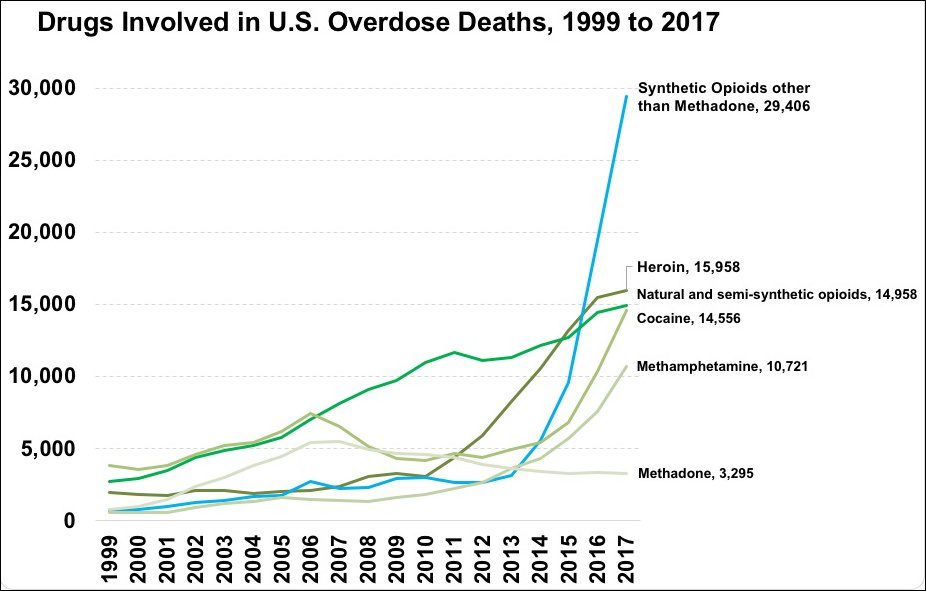
As another example of this pattern, hear what McKenna says based on his research into use of alcohol:
Human use of alcohol in the form of fermented grains, juices, and mead is extremely ancient. Distilled spirits, in contrast, were not known to the ancients. Alcoholism as a social and community problem appears to have been rare before the discovery of distillation.
A new tool for ending addiction?
This being the reality, we need to take the problem of addiction seriously. And this means putting aside failed approaches that have failed miserably in the past like prohibition. It’s ironic in a way, that hallucinogenic plants may represent a future path out of addiction.
A recent pilot study done by Johns Hopkins tried giving one dose of psilocybin in a therapeutic setting to 15 people who had repeatedly failed to quit cigarettes. Most of the patients quit smoking, and after 6 months, they found that 80% of the subjects continued to be abstinent.
The head researcher of this study was Roland Griffiths, who we’ve mentioned a couple times already. When asked about these positive results, he said:
People who have taken psilocybin appear to have more confidence in their ability to change their own behavior and to manage their addictions. Prior to this experience, quite often the individual feels that they have no freedom relative to their addiction, that they are hooked and they don’t have the capacity to change. But after an experience of this sort—which is like backing up and seeing the larger picture—they begin to ask themselves ‘Why would I think that I couldn’t stop cigarette smoking?
– Roland Griffiths, scientist at John Hopkins
The false dichotomy of substance and behavioral addiction
Now, let’s take a step back. What is addiction anyway? Defined in the broadest way, an addiction is something that causes compulsive behavior. In fact, to see addiction only as the consumption of certain substances is a very narrow view. Therefore McKenna proposes a new definition of “drug” as “something that causes unexamined, obsessive and habitual behavior.” If our goal is to thrive collectively as a society, then we need to examine all sources of these compulsive and destructive behavior patterns.
Take television for example. We’ve all heard the shocking statistics before that most people spend 4-6 hours per day watching television. Of course, now the internet and mobile devices have somewhat replaced television. And according to a 2018 Nielson report, the average adult now spends over 11 hours every day watching or interacting with media.
This habit has many destructive effects: deteriorates relationships, harms health and erodes attention spans. But beyond that, television and other media also make us into consumers of the images other people feed us. As McKenna says:
Television is by nature the dominator drug par excellence. Control of content, uniformity of content, repeatability of content make it inevitably a tool of coersion, brainwashing, and manipulation.
Even worse, these digital addictions seem to be following a similar trend as the physical drugs. Over time they are becoming more potent. We went from a weekly newspaper, to a daily news hour, to now our phones constantly buzzing in our pockets. Is there any way out of this?
Well, decades before the term “psychedelic” caught on, these plants were called “consciousness-expanding.” Aldous Huxley wrote about how they “opened the doors of perception” and helped him reconnect with the world as it is, including deeper self-reflection.
And if Terence McKenna is right and consciousness-expanding plants accidentally opened the doors of perception for us homo sapiens thousands of years ago, then perhaps after being slammed shut for so long, the door is creaking open again. And maybe this time, in contrast to the wild 1960’s counterculture, these archaic sacraments can be reintroduced on a solid foundation and become an integral part of future mental health and individual religious inquiry.
Our addictions down through the ages, from sugar to cocaine and television, have been a restless search for the thing torn from us in paradise. The answer has been found. It is no longer something to be sought. It has been found.


